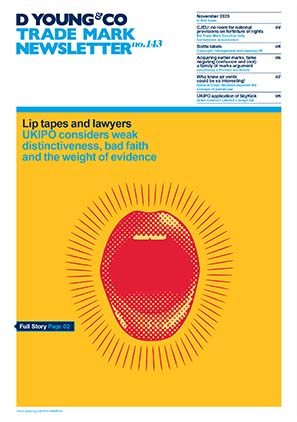Battle of the budget badges: Lidl v Tesco
Lidl has succeeded in its claim to trade mark infringement, copyright infringement and passing off in its word and wordless blue and yellow logo (figure 1 below) in relation to Tesco’s use of the blue and yellow Clubcard Prices logo (figure 2 below):


Background
Lidl has been using the Lidl & logo (figure 1, top left) version of the mark since 1994, and while the standalone wordless (figure 1, top right) version of the mark has never been used in the UK it has been registered here since 1995. Tesco began using its own logo (figure 2, left and right) in 2020, in relation to the Tesco Clubcard loyalty scheme to promote discounts for Clubcard holders at the point of sale, in signage and advertising. Despite Lidl’s requests for this use to cease Tesco carried on.
Lidl instigated High Court proceedings claiming trade mark infringement, copyright infringement and passing off. Tesco counterclaimed for revocation on the grounds of non-use. It also sought a declaration of invalidity of the wordless mark on the grounds that it lacked distinctive character and on bad faith grounds based on the fact it had never been used, Lidl had no intention to use it, and had “evergreened” by regularly re-applying for the trade mark for a very broad range of goods and services.
The decision
Trade mark infringement under section 10(3)
Lidl was successful in its claim showing that it enjoys a sufficient reputation in both the word and wordless versions of the mark (despite never having used the wordless version in the UK), and notably that the Lidl and Clubcard logo marks were considered visually similar despite the different wording (or lack of). Lidl were able to show that consumers understood the wordless mark in itself to be distinctive of Lidl as a brand, despite never having been used in the wordless form. This may have impact on future “lookalike” cases, where there is similar get-up and livery but completely different verbal branding. However, the survey and witness evidence submitted by Lidl went a long way to establishing that the average consumer would make a link between the marks at issue. It is certainly not a given that future cases will automatically follow this judgment.
Passing off
Lidl succeeded in its claim by showing that it had the necessary goodwill in the marks (based on the evidence already adduced in the trade mark claims), and that a substantial proportion of consumers would be deceived by the Clubcard signs and believe that Tesco’s Clubcard price is the same as or lower than Lidl’s price for equivalent goods. Since this was not the case, Lidl had suffered damage, not because the consumer believed there to be a connection between the parties, but because they would lose sales due to a lack of price comparison by consumers. This “misrepresentation by equivalence” amounted to passing off.
Copyright infringement
The judge found that copyright existed in the combination of the yellow circle within a blue square (with the Lidl word mark within the yellow circle), and that Tesco had copied a substantial part of this when creating the Clubcard logo. Tesco was unable to provide an explanation for the similarity between the marks – the fact that it did not call any witnesses from its external design agency led the court to draw adverse inferences. Therefore the copyright infringement claim was also successful.
Counterclaim
Tesco failed in its non-use claim of the wordless logo, as the judge held that use of the word logo supported registration of the wordless logo, noting in fact that the wordless logo itself functions as a brand (as shown through the evidence submitted). However, it did succeed in relation to the invalidity actions based on bad faith.
The judge asserted that Lidl needed to adduce positive evidence of an intention to use the wordless logo at the time the first trade mark application was filed (1995). Unsurprisingly, given the passage of time and changes in personnel, Lidl could not do this and therefore could not prove the relevant good faith. Accordingly, the judge held that the first registration was filed as a legal weapon, and that the subsequent three registrations (filed in 2002, 2005 and 2007) were intended as “evergreening rights”.
The bad faith claim based on intent at the time of filing was successful despite the finding that the wordless mark had been extensively used. The latest filing for the wordless mark (in 2021) was found not to have been in bad faith owing to the significant eleven year gap between the respective filing dates, and evidence from Lidl that it believed it was genuinely using the wordless mark by this stage.
Important points for the shopping basket
Since its handing down back in April 2023, there have been many comment pieces on the importance of this decision for brand owners wanting to take action against copycat products. In our view, while this may be a valid argument to some extent (based largely on any reputation in earlier registered rights for logo/device marks), the decision is very fact-specific and should not be taken as opening the floodgates to successful claims in other lookalike cases.
In our view the most crucial aspects of the decision are as follows.
The importance of good evidence, and in particular survey evidence and “Vox Populi”
The “vox pop” evidence was a collection of feedback spontaneously volunteered by consumers to Lidl and Tesco when the Tesco campaign using the Clubcard logo went live, which appears to have been gathered through a very meticulous and thorough search of social media posts. As it was spontaneous feedback rather than specifically conducted survey evidence it seems to have been especially persuasive for the judge. However, the YouGov Survey evidence adduced by Lidl was also impressive. When shown the wordless Lidl mark and asked the question “What do you think this image is?” 73% of responses mentioned Lidl alone. This went a long way to proving the wordless logo is a distinctive identifier of Lidl, despite the mark never having been used per se in the UK.
Without this evidence the result may have been quite different. It may therefore be possible to overcome a party’s understandable reluctance to rely on survey evidence where it is well constructed and carefully conducted.
The intention of the trade mark owner at the time of filing
If you have no intention to use a mark at the point of filing it can still amount to a bad faith filing even if you go on to use it. Therefore, it is important to be able to justify your intentions by keeping records that could be disclosed in later proceedings if a filing is challenged. Trade mark owners should also be wary of “over-filing”, either in terms of classes or different versions of a mark. In addition, the issue of evergreening, where brand owners seek to re-register their marks every few years in order to avoid a non-use revocation action, should not be undertaken as a matter of course without consideration of a potential bad faith claim.
Unsurprisingly, Tesco has sought permission to appeal the decision. The battle of the badges may not yet be over.
Case details at a glance
Jurisdiction: England & Wales
Decision level: High Court
Parties: Lidl Great Britain Ltd and Lidl Stiftung & Co KG v Tesco Stores Ltd and Tesco Plc
Citation: [2023] EWHC 873 (Ch)
Date: 19 April 2023

